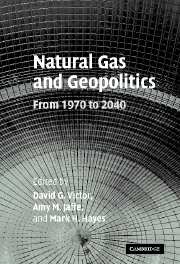Book contents
- Frontmatter
- Contents
- List of figures
- List of tables
- List of boxes
- List of contributors
- Foreword by James A. Baker, III
- Acknowledgments
- List of acronyms and abbreviations
- Part I Introduction and context
- Part II Historical case studies
- 2 Introduction to the historical case studies: research questions, methods and case selection
- 3 The Transmed and Maghreb projects: gas to Europe from North Africa
- 4 Liquefied natural gas from Indonesia: the Arun project
- 5 Bypassing Ukraine: exporting Russian gas to Poland and Germany
- 6 Natural gas pipelines in the Southern Cone
- 7 International gas trade in Central Asia: Turkmenistan, Iran, Russia, and Afghanistan
- 8 Liquefied natural gas from Qatar: the Qatargas project
- 9 Liquefied natural gas from Trinidad & Tobago: the Atlantic LNG project
- 10 Politics, markets, and the shift to gas: insights from the seven historical case studies
- Part III International gas trade economics
- Part IV Implications
- Appendix: Technical notes
- Index
- References
4 - Liquefied natural gas from Indonesia: the Arun project
Published online by Cambridge University Press: 22 September 2009
- Frontmatter
- Contents
- List of figures
- List of tables
- List of boxes
- List of contributors
- Foreword by James A. Baker, III
- Acknowledgments
- List of acronyms and abbreviations
- Part I Introduction and context
- Part II Historical case studies
- 2 Introduction to the historical case studies: research questions, methods and case selection
- 3 The Transmed and Maghreb projects: gas to Europe from North Africa
- 4 Liquefied natural gas from Indonesia: the Arun project
- 5 Bypassing Ukraine: exporting Russian gas to Poland and Germany
- 6 Natural gas pipelines in the Southern Cone
- 7 International gas trade in Central Asia: Turkmenistan, Iran, Russia, and Afghanistan
- 8 Liquefied natural gas from Qatar: the Qatargas project
- 9 Liquefied natural gas from Trinidad & Tobago: the Atlantic LNG project
- 10 Politics, markets, and the shift to gas: insights from the seven historical case studies
- Part III International gas trade economics
- Part IV Implications
- Appendix: Technical notes
- Index
- References
Summary
Introduction
The Arun natural gas project in Northern Sumatra is probably the most lucrative LNG operation in the twentieth century. This chapter analyzes the issues involved in the transmission of that gas to potential buyers and why Japan became Arun's only foreign market in its first two decades. Following a description of the development of the Arun field and its LNG facilities, we review the agreements made with the initial buyers. To explain the context in which these contracts evolved, we analyze Pertamina, the Indonesian national oil company, and the political and economic conditions in the Republic at the time. We give considerable attention to the long-term impact of this trade on the Japanese and Northeast Asian gas markets, the contractual relations between Pertamina and Japanese buyers, and competition among those buyers.
The basic thrust of this analysis is that Japan was the only viable customer for Arun's gas in the initial decade after discovery. Japan had a need for clean energy, was prepared to use LNG, and was willing to finance the project in Indonesia. There was not a sufficient domestic market in Indonesia at the time and Arun was perceived to be geographically too far from its population center. The rest of East and South Asia had not developed to the point of usefully importing LNG and did not have the ability to finance these operations. Singapore was later to become an importer of gas piped from Indonesia, but at the time was not interested in Arun.
- Type
- Chapter
- Information
- Natural Gas and GeopoliticsFrom 1970 to 2040, pp. 91 - 121Publisher: Cambridge University PressPrint publication year: 2006
References
- 3
- Cited by



